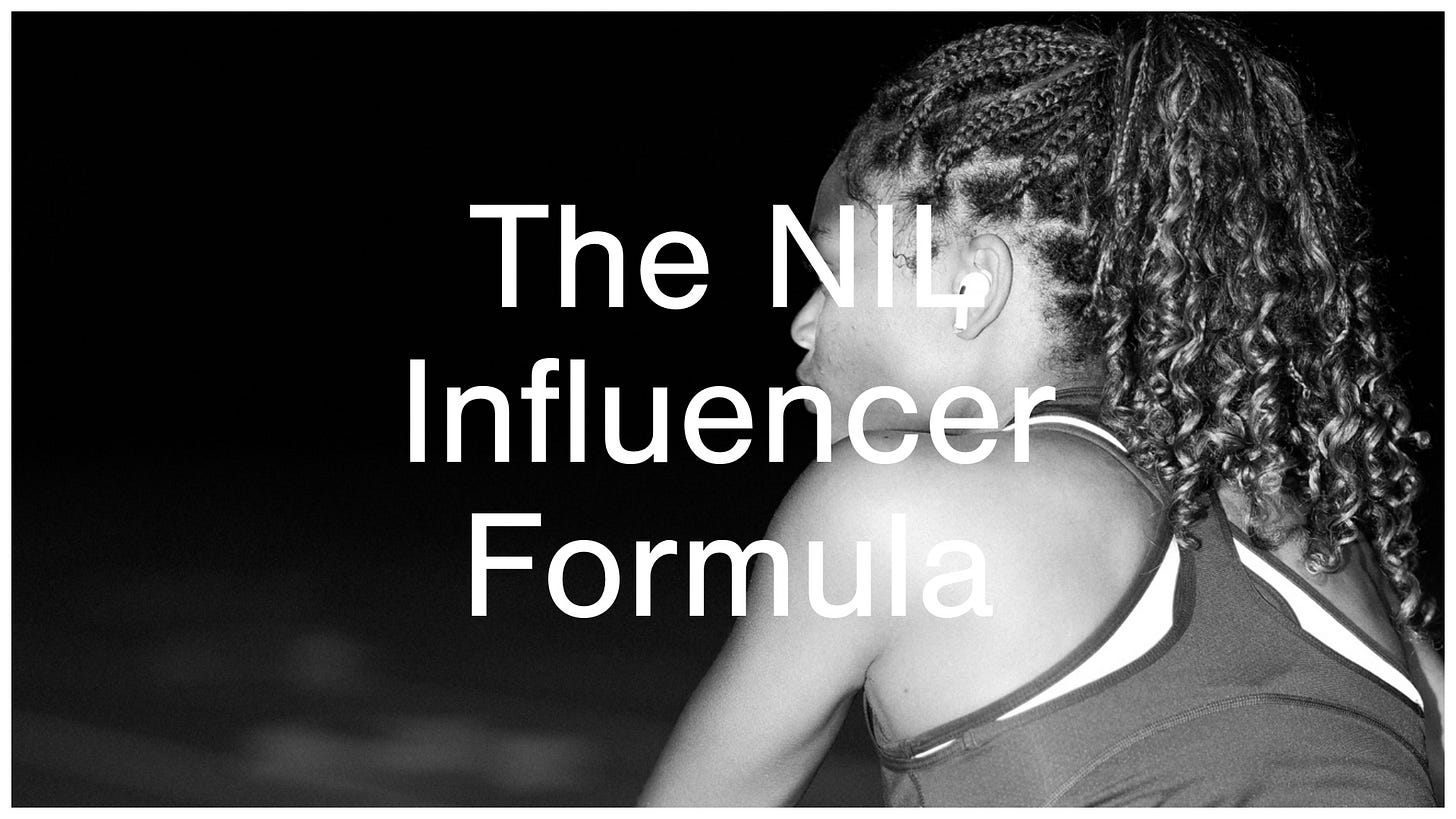[Get free access to my digital NIL course used at 30+ universities - NIL Quickstart (usually $200.) Here’s how: Follow me on LinkedIn at https://www.linkedin.com/in/billcarternil/, then send me a DM with the word “Quickstart.” I’ll reply with free access to the course. It’s that easy.]
Why NIL Is Really About Influencer Marketing
When people hear "NIL," most immediately think of endorsements. And when they think of endorsements, they picture the biggest names - the quarterback on national TV, the All-American gymnast with a million TikTok followers.
But that’s only part of the picture.
The most common way student-athletes are earning NIL income today is social media. According to our NIL Research Poll, over 85% of all NIL transactions involve some form of influencer-style activation: posting on Instagram, sharing a product in Stories, creating content for TikTok, or even tagging a brand in a game-day post.
NIL is influencer marketing.
And if you’re a brand looking to partner with student-athletes - or a coach or administrator trying to help them - you need to understand how influencer selection really works.
Successful Brands Start with Their Goals
The biggest mistake I see brands make in NIL? Picking the athlete first and the objective second.
Smart brands don’t just look for reach or star power. They start with questions:
Are we trying to reach a specific group (e.g. high school athletes, college students, young women in sports)?
Is the goal to drive traffic to our site? Sales? Email sign-ups?
Do we want to associate our brand with values like hard work, community, or leadership?
Once a brand knows what they’re trying to achieve, then they go looking for the right partner - someone who can make that happen through authentic content.
NIL isn’t about who has the biggest follower count. It’s about who’s the best fit.
What Brands Actually Look for in a Student-Athlete Influencer
Here’s what brands are looking at:
Demographics
What’s the athlete’s age, gender, and school location? Does that align with the brand’s target audience?
Content Style
Is the athlete funny? Inspirational? Educational? Are they posting behind-the-scenes content, lifestyle moments, or wellness tips? Does their content feel consistent with the brand’s tone?
Platform Presence
Where are they most active?
Instagram is the top NIL platform, especially for lifestyle brands.
TikTok is great for reaching a younger audience.
YouTube is king for long-form storytelling, but harder to grow.
Twitter/X is less valuable.
Engagement, Not Just Followers
10,000 followers with 500 likes per post outperforms 50,000 followers with 100 likes per post. Engagement is a better predictor of influence than reach.
Audience Alignment
Brands aren’t paying to reach everyone. They’re paying to reach the right ones.
Influencer Tiers
Brands don’t just sort by “fame.” They think in tiers.
Here’s a quick breakdown brands often use, adapted to the NIL context:
Nano Influencer (1K–10K followers)
Pros:
Extremely high engagement
Strong niche loyalty
Very affordable for brands
Cons:
Limited reach
Often newer to content creation
Micro Influencer (10K–50K followers)
Pros:
Strong influence within their niche
Great value and cost-effective
Semi-professional content production
Cons:
Still growing audience
May lack polish or experience
Mid-Tier Influencer (50K–100K followers)
Pros:
Broader audience reach
Professional-quality content
Loyal follower base
Cons:
Higher costs
Engagement may decline as audience grows
Macro Influencer (100K–1M+ followers)
Pros:
Mass exposure and large-scale visibility
Strong brand recognition
High production value
Cons:
Expensive
Feels less personal or authentic
Lower engagement rates compared to smaller tiers
What Brands Avoid: Red Flags in Influencers
Here’s what can make even a talented, charismatic athlete an instant “no” for brand deals:
Inconsistent Posting: If the athlete hasn’t posted in the past month, brands assume their audience isn’t engaged.
Low-Quality Content: Dark, grainy, or sloppy posts signal a lack of professionalism.
Fake Engagement: Bot comments, purchased followers, or inflated likes can be spotted a mile away by savvy marketers.
Over-saturation: If 7 out of 10 posts are sponsored, that athlete’s credibility is probably declining. Brands want partnerships, not just ads.
Content Misalignment: It’s common sense. If a wellness brand sees an athlete’s feed filled with sugary soft-drink content, they’ll walk away.
Poor Communication: Slow replies, missing deadlines, or vague deliverables can ruin deals quickly.
Athletes don’t need to be perfect. But they do need to be prepared.
What Coaches and Admins Can Do to Help Athletes Succeed
You don’t need to be a social media expert to help your athletes navigate NIL. But you do need to understand what matters.
Help Athletes Build a Personal Brand
This doesn’t mean picking a logo or tagline. It means helping them understand: What do I want to be known for?
The best NIL-earning athletes have a clear identity that goes beyond sport.
Encourage Smart, Consistent Posting
Encourage regular posting - pre-game content, workouts, leadership moments.
Offer Practical NIL Education
Workshops, online courses, or 1-on-1 coaching can teach athletes how to:
Reach out to brands professionally
Read basic contracts
Price themselves appropriately
Disclose partnerships properly
Most brands expect student-athletes to be new to this. They just want to know the basics are covered.
Subscribe today ($5 per month) to get access to the rest of this edition. You will get 4 newsletters per month, and all past content.
What Brands Should Remember About Student-Athletes
Working with student-athletes is different from working with full-time influencers.
They’re students first. They have practice, travel, and academic commitments. They’re still learning to manage their voice and their time.
But that’s also what makes them powerful.
Athletes have built-in credibility, discipline, and community presence. They’re followed by future recruits, classmates, alumni, and local fans. When they speak, people listen.
And when they speak authentically, it works.
The Real Magic: Finding the Overlap
The best NIL partnerships happen when three things align:
The brand knows what it wants to achieve
The athlete knows who they are and what they stand for
The school supports the athlete in building that foundation
If you’re a brand, your best NIL partner might not be the biggest star on campus.
If you’re a coach, your best recruiting advantage might be teaching your athletes how to show up online.
And if you’re a student-athlete? Remember this: You don’t need a million followers. You need to know your story—and be willing to share it.
Bill Carter is a leading NIL educator and consultant and founder of Student-Athlete Insights. He provides digital courses, live workshops, and consulting to help High School & College Athletes to turn their NIL into income. Bill can be contacted at bill@studentathleteinsights.com.





